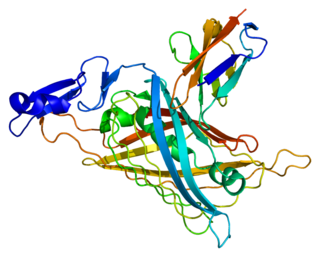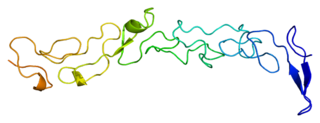
Nidogen-1 (NID-1), formerly known as entactin, is a protein that in humans is encoded by the NID1 gene. Both nidogen-1 and nidogen-2 are essential components of the basement membrane alongside other components such as type IV collagen, proteoglycans, laminin and fibronectin.

Laminins are a family of glycoproteins of the extracellular matrix of all animals. They are major constituents of the basement membrane, namely the basal lamina. Laminins are vital to biological activity, influencing cell differentiation, migration, and adhesion.

Fibroblast growth factor 1, (FGF-1) also known as acidic fibroblast growth factor (aFGF), is a growth factor and signaling protein encoded by the FGF1 gene. It is synthesized as a 155 amino acid polypeptide, whose mature form is a non-glycosylated 17-18 kDa protein. Fibroblast growth factor protein was first purified in 1975, but soon afterwards others using different conditions isolated acidic FGF, Heparin-binding growth factor-1, and Endothelial cell growth factor-1. Gene sequencing revealed that this group was actually the same growth factor and that FGF1 was a member of a family of FGF proteins.

Perlecan (PLC) also known as basement membrane-specific heparan sulfate proteoglycan core protein (HSPG) or heparan sulfate proteoglycan 2 (HSPG2), is a protein that in humans is encoded by the HSPG2 gene. The HSPG2 gene codes for a 4,391 amino acid protein with a molecular weight of 468,829. It is one of the largest known proteins. The name perlecan comes from its appearance as a "string of pearls" in rotary shadowed images.
Nidogens, formerly known as entactins, are a family of sulfated monomeric glycoproteins located in the basal lamina of parahoxozoans. Two nidogens have been identified in humans: nidogen-1 (NID1) and nidogen-2 (NID2). Remarkably, vertebrates are still capable of stabilizing basement membrane in the absence of either identified nidogen. In contrast, those lacking both nidogen-1 and nidogen-2 typically die prematurely during embryonic development as a result of defects existing in the heart and lungs. Nidogen have been shown to play a crucial role during organogenesis in late embryonic development, particularly in cardiac and lung development. From an evolutionary perspective, nidogens are highly conserved across vertebrates and invertebrates, retaining their ability to bind laminin.

Osteonectin (ON) also known as secreted protein acidic and rich in cysteine (SPARC) or basement-membrane protein 40 (BM-40) is a protein that in humans is encoded by the SPARC gene.

Heterogeneous nuclear ribonucleoprotein K is a protein that in humans is encoded by the HNRNPK gene. It is found in the cell nucleus that binds to pre-messenger RNA (mRNA) as a component of heterogeneous ribonucleoprotein particles. The simian homolog is known as protein H16. Both proteins bind to single-stranded DNA as well as to RNA and can stimulate the activity of RNA polymerase II, the protein responsible for most gene transcription. The relative affinities of the proteins for DNA and RNA vary with solution conditions and are inversely correlated, so that conditions promoting strong DNA binding result in weak RNA binding.

FBLN1 is the gene encoding fibulin-1, an extracellular matrix and plasma protein.

Collagen alpha-1(XVIII) chain is a protein that in humans is encoded by the COL18A1 gene.

Collagen alpha-3(IV) chain is a protein that in humans is encoded by the COL4A3 gene.

Collagen alpha-1(IV) chain (COL4A1) is a protein that in humans is encoded by the COL4A1 gene on chromosome 13. It is ubiquitously expressed in many tissues and cell types. COL4A1 is a subunit of the type IV collagen and plays a role in angiogenesis. Mutations in the gene have been linked to diseases of the brain, muscle, kidney, eye, and cardiovascular system. The COL4A1 gene also contains one of 27 SNPs associated with increased risk of coronary artery disease.

Collagen alpha-4(IV) chain is a protein that in humans is encoded by the COL4A4 gene.

Laminin subunit alpha-3 is a protein that in humans is encoded by the LAMA3 gene.

40S ribosomal protein SA is a ribosomal protein that in humans is encoded by the RPSA gene. It also acts as a cell surface receptor, in particular for laminin, and is involved in several pathogenic processes.

Laminin subunit alpha-1 is a protein that in humans is encoded by the LAMA1 gene.

Laminin subunit gamma-1 is a protein that in humans is encoded by the LAMC1 gene.

Laminin subunit alpha-2 is a protein that in humans is encoded by the LAMA2 gene.

Collagen alpha-6(IV) chain is a protein that in humans is encoded by the COL4A6 gene.

Fibulin-2 is a protein that in humans is encoded by the FBLN2 gene.

ATP-binding cassette sub-family F member 2 is a protein that in humans is encoded by the ABCF2 gene.




















